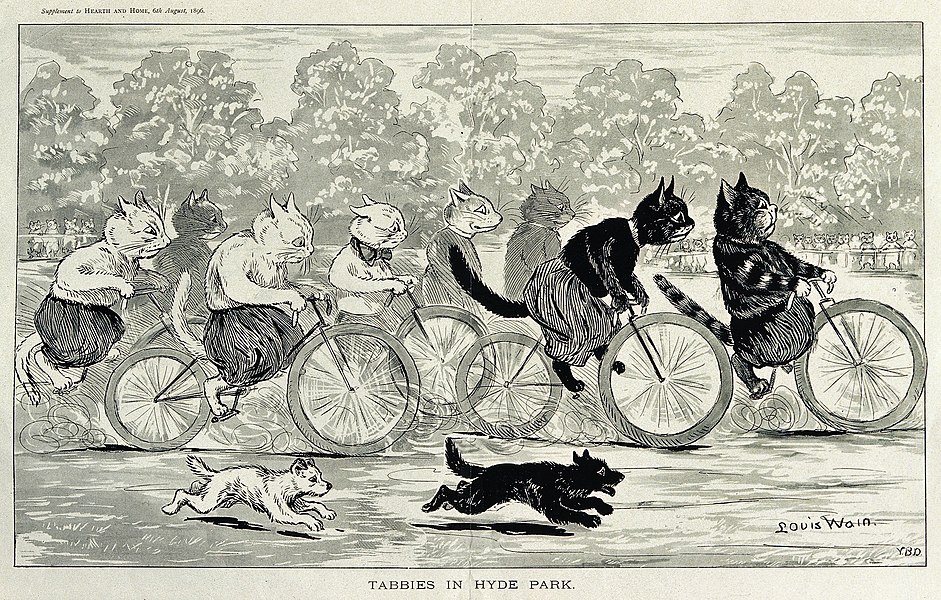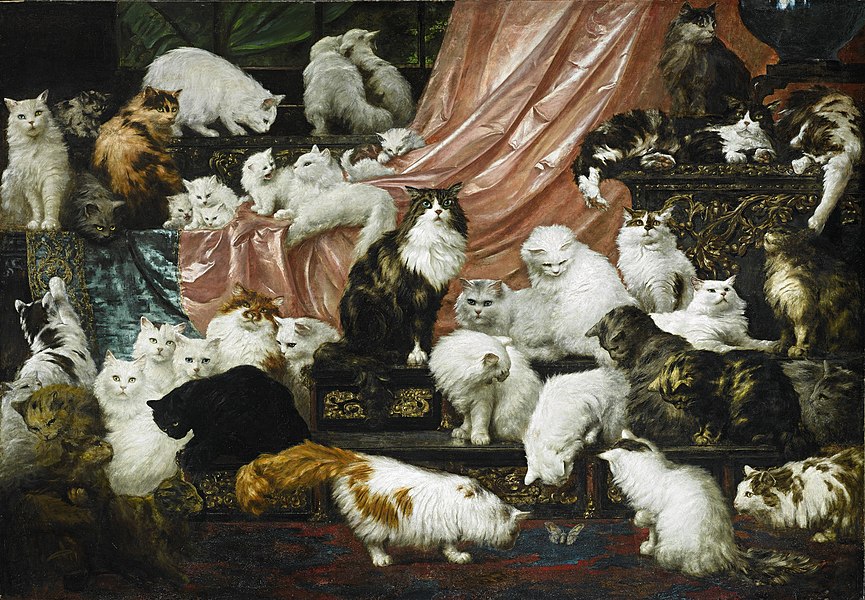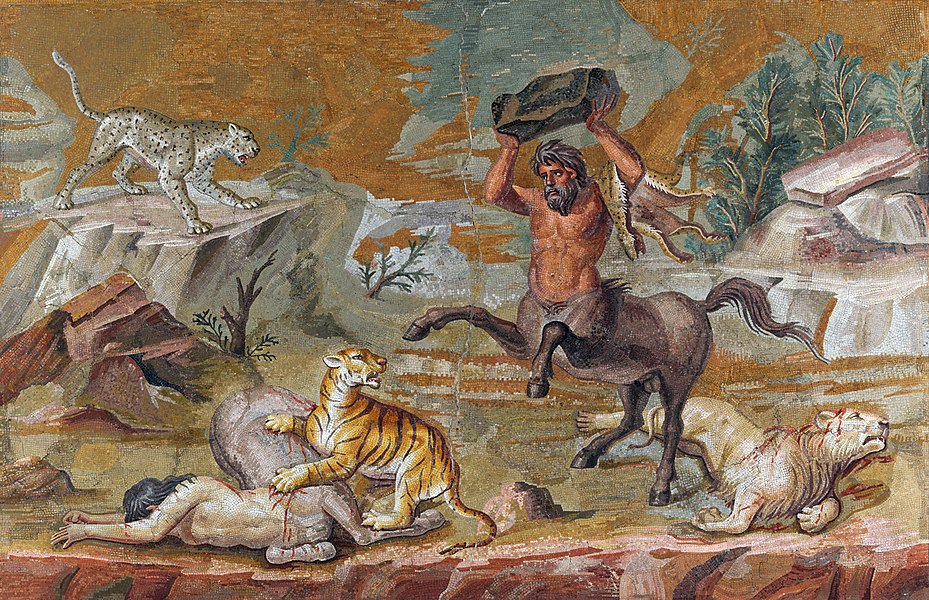 1
1title: 'Cats Suggested as The Fifty-three Stations of the Tōkaidō'
artist:
歌川国芳 (Utagawa Kuniyoshi, 1798 - 1861)date: 1850
medium: Technique woodcut print
dimensions: size cm 37.4 77.8
source: link PD-old
credit: link
license:Public domain
 2
2title: Bonaparte premier Consul Gérard Chantilly
artist: François Gérard
date: 1803
medium: oil on canvas
dimensions: size cm 62 53
current location: Museum:Musée Condé
source: [[User:Jebulon|Jebulon]] ( taken in|2011 )
credit: Jebulon (Taken in )
license:Public domain
 3
3title: Théophile Alexandre Steinlen - Tournée du Chat Noir de Rodolphe Salis (Tour of Rodolphe Salis' Chat Noir) - Google Art Project
artist: Théophile Steinlen
date: 1896
medium: Color lithograph
dimensions: w959 x h1359 mm
current location: Zimmerli Art Museum at Rutgers University
credit: BAEF9F-mDJvr0A at Google Cultural Institute maximum zoom level
license:Public domain
 4
4title: A group of cats engaged in a cycle race in Hyde Park, London Wellcome V0023074
artist: unknown
description:
A group of cats engaged in a cycle-race in Hyde Park, London. Processed print after L. Wain.
Iconographic Collections
Keywords: Louis William Wainlicense:
CC BY 4.0
 5
5title: Cats in human dress playing a variety of games, including ar Wellcome V0047334
artist: unknown
source: link * Gallery: link * Wellcome Collection gallery (2018-03-27): link [link CC-BY-4.0]
credit: link Gallery: link Wellcome Collection gallery (2018-03-27): link CC-BY-4.0
description:
cats in human dress playing a variety of games, including arm wrestling and tug of war. Colour woodcut by Kunimasa IV, 1870s.
Iconographic Collections
Keywords: Kunisadalicense:
CC BY 4.0
 6
6title: Malhoa February 2015 9a
artist: José Malhoa
medium: Technique painting
current location: Museum José Malhoa, Caldas da Rainha, Portugal <!--within the institution-->
source: own [[User:Alvesgaspar|Alvesgaspar]]
credit: Own work Alvesgaspar
license:Public domain
 7
7title: My Wife's Lovers
artist: Carl Kahler
date: 1893
dimensions: 70 by 101 3/4 in. 177.8 by 258.4 cm
source: [link Sotheby's sale 3 November 2015]
credit: Sotheby's sale 3 November 2015
license:Public domain
 8
8title: Jean Baptiste Perronneau - Magdaleine Pinceloup de la Grange, née de Parseval
artist: Jean-Baptiste Perronneau
source: link Assessments|featured=1|valued=1
credit: link
license:Public domain
 9
9title: Centaur mosaic Google Art Project retouched.
artist:
date: (120 - 130)
dimensions: w915 x h585 cm
current location: Altes Museum, Staatliche Museen zu Berlin
credit:
SwHAQhNGz6l7_Q at Google Cultural Institute zoom level scaled
down from maximum resolutiondescription: The centaur mosaic was found in the 18th century on the site of the sprawling, luxurious villa complex near Tivoli that once belonged to the Roman emperor Hadrian. The mosaic was found in situ along with other smaller ones that bore depictions of landscapes, animals and masks. The relatively small central panel (emblema) formed part of the floor decoration for the dining room (triclinium) in the main palace. The various individual scenes of these mosaic pictures bear depictions of wild, inhospitable landscapes that deliberately contrast with idyllic ones featuring animals living in harmony with each other. The dangers of the wild are portrayed in this mosaic in the dramatic struggle between great cats and a pair of centaurs, mythological creatures with the head, arms, and torso of a man and the body and legs of a horse. On a rocky outcrop that hangs over a terrific chasm that runs parallel to the bottom of the picture, a pair of centaurs have been pounced on by great cats. While the male centaur has been able to defend itself successfully from the lion, the tiger has managed to bring the female centaur to the ground and is clawing her side. The male centaur rushes to his companion’s side, rearing his legs in the air while holding a rock aloft above his head. Undaunted, the tiger seems intent on not surrendering its prey. Even though one lion already lies fatally wounded, bleeding and with its claws retracted, the outcome of the struggle is anything but clear because in the background (whose spatial depth is achieved through the staggered arrangement of rock forms and impressive gradations of colour) we see yet another foe for the centaur: a leopard ready to pounce. While depictions in older Greek art tended to emphasise the bestial side of centaurs, later depictions increasingly focussed on their human qualities. Lucian, a writer from the 2nd century, records that the Greek painter Zeuxis (active around 400 BCE) became famous for his painting of a family of centaurs, including the young, set in a rural idyll. Similarly, Ovid, who lived around the turn of the millennium, wrote in moving verse of the death of a centaur couple. The extensive restoration work that was undertaken in the 18th and 19th century makes it difficult to date the mosaic with certainty. As a result, its dating ranges from Hellenistic to Hadrianic. There is broad agreement among scholars that the mosaic amounts to one of most virtuoso works of Roman mosaic art, which was inspired by a Greek work of art (either a panel painting or mosaic) from the Hellenistic period.
license:Public domain

title: Centaur mosaic Google Art Project - CropFrame - Plus1ev
artist:
date: (120 - 130)
dimensions: w915 x h585 cm
current location: Altes Museum, Staatliche Museen zu Berlin
credit: SwHAQhNGz6l7_Q at Google Cultural Institute maximum zoom level
description: The centaur mosaic was found in the 18th century on the site of the sprawling, luxurious villa complex near Tivoli that once belonged to the Roman emperor Hadrian. The mosaic was found in situ along with other smaller ones that bore depictions of landscapes, animals and masks. The relatively small central panel (emblema) formed part of the floor decoration for the dining room (triclinium) in the main palace. The various individual scenes of these mosaic pictures bear depictions of wild, inhospitable landscapes that deliberately contrast with idyllic ones featuring animals living in harmony with each other. The dangers of the wild are portrayed in this mosaic in the dramatic struggle between great cats and a pair of centaurs, mythological creatures with the head, arms, and torso of a man and the body and legs of a horse. On a rocky outcrop that hangs over a terrific chasm that runs parallel to the bottom of the picture, a pair of centaurs have been pounced on by great cats. While the male centaur has been able to defend itself successfully from the lion, the tiger has managed to bring the female centaur to the ground and is clawing her side. The male centaur rushes to his companion’s side, rearing his legs in the air while holding a rock aloft above his head. Undaunted, the tiger seems intent on not surrendering its prey. Even though one lion already lies fatally wounded, bleeding and with its claws retracted, the outcome of the struggle is anything but clear because in the background (whose spatial depth is achieved through the staggered arrangement of rock forms and impressive gradations of colour) we see yet another foe for the centaur: a leopard ready to pounce. While depictions in older Greek art tended to emphasise the bestial side of centaurs, later depictions increasingly focussed on their human qualities. Lucian, a writer from the 2nd century, records that the Greek painter Zeuxis (active around 400 BCE) became famous for his painting of a family of centaurs, including the young, set in a rural idyll. Similarly, Ovid, who lived around the turn of the millennium, wrote in moving verse of the death of a centaur couple. The extensive restoration work that was undertaken in the 18th and 19th century makes it difficult to date the mosaic with certainty. As a result, its dating ranges from Hellenistic to Hadrianic. There is broad agreement among scholars that the mosaic amounts to one of most virtuoso works of Roman mosaic art, which was inspired by a Greek work of art (either a panel painting or mosaic) from the Hellenistic period.
license:Public domain





